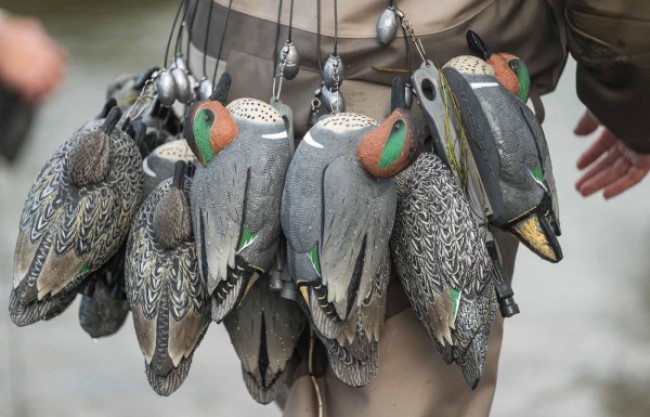Hunting
Ain’t Nothing But a Teal Thang, Baby
Ready your shotgun, decoys, and camo duds…the season’s opening salvo is but weeks away.
When Mother Nature kicks the natural air-conditioning on sometime mid-August, it’s always a much welcome reprieve from sweltering summer weather. The change beckons hunters with their first real sense of what is coming only a few weeks away. They know, tiny ducks will be sweeping southward from their northern breeding grounds through the starlit sky on a light northern breeze.
The first days of September are permanently etched in the wing shooters psyche. The tradition and pageantry of the dove opener is a rite of passage for many hunters, and this perennial favorite tune-up for wing shooters is regularly squeezed in between early-season goose and teal hunts by even the most dedicated waterfowlers. But the allure of teal hunting is something some will choose over the other two options, as these hunters consider hordes of bluewings jetting around the marsh, flooding, or river bottom one of the highlights of a waterfowl season.
Blue-winged teal migrate south earlier than other species and many end up wintering in the Gulf States, Caribbean, Mexico, as well as much of the rest of Latin America – in essence anywhere summer-like conditions are prevalent during winter. Bluewings are also the last species to migrate north in the spring, and while the vast-majority nest in the Prairie Pothole Region of the northern plains of the US and the adjacent Canadian prairie, a surprising contingent nest within the lower 48 states.
Both blue-winged and green-winged teal can be found throughout North America during the migration, but the majority of bluewings migrate through the Central and Mississippi flyways in August and September. While a decent number of green-winged teal follow the backend of this early migration, this, the smallest species of dabbling duck found in North America really gets revved-up during the early portions of the regular season and quickly become a mainstay target throughout the entire season for waterfowlers in states south of the snow and ice line.
The cinnamon teal’s range is the western third of the US, and although this species is very similar to the bluewing in size and markings such as their telltale blue wing patch, as the name implies, their overall coloration is what can only be described as a stunning cinnamon red color. This makes the cinnamon teal one of the most sought-after trophy species.
Teal are plentiful, often only second to mallards in abundance. They can be challenging targets, though, and regularly appear in frenzied swarms that “ball up” over the decoys. They taste great and offer generous bag limits, and teal are small enough to fit into a small cooler on ice, if you must race to work and don’t have time to field dress your bag until later.
Unlike big-production duck hunts later in the season, hunting teal is relatively easy from a gear standpoint. This includes wearing the most comfortable hunting outfit of the season – often shorts and t-shirt. And teal are rarely difficult to decoy, and flocks will often explode over the decoys within 20 yards.
And thankfully, the three primary teal species regularly mingle together, so using decoys that don’t necessarily match the species you’re encountering work fine. This includes the far less abundant cinnamon, which regularly ends up belly-up among bluewing and greenwing decoys.
Typically, a dozen or two bluewing decoys is enough for early season teal hunting, and it never hurts to mix in some greenwing, either, which incidentally can come in handy during regular duck seasons to beef up spreads and add realism to a mid to late season spreads, otherwise dominated by mallard decoys.
Teal are also suckers for spinning wing decoys and hunts can quickly become a point and shoot endeavor. This is a great opportunity to use sub-gauge shotguns that fire light loads through open chokes. Many veteran teal hunters use the very same non-toxic dove loads required on public hunting areas to bag teal hanging over the decoys. The reality is, they aren’t difficult to bring down and the target size is very similar to smaller game species such as quail, woodcock, grouse, and yes, dove. Standard length shells loaded with smaller shot sizes are certainly good enough for teal, plus, these loads don’t cost nearly as much as the bigger offerings.
Hunters who primarily rely on September’s near daily teal migration (as opposed to birds that are hanging around) may want to increase their decoy spread’s size, and this is especially the case where thick vegetation is present. While teal love moist soil and flooded rice or millet so often managed specifically to attract them, they will be drawn to any kind of marshy habitat, and these areas are often heavily vegetated. Remember, teal have a habit of taking a lap or two around a given area to inspect options, and whoever has the best visibility will often win their praise.
You’re not always competing with other hunters, but actual teal may already be on the water, which is why it’s so important to use decoys that possess “pop”, with clean, realistic paint jobs. The further south you are hunting the more important this becomes. This is due to the simple fact that these rapid-migrating ducks may encounter hunters at any given time as they race southward. While teal may not be as prone to become as “unworkable” as stale mallards and pintails that have repeatedly dealt with similar interactions with hunters, any resource that mitigates a duck’s ability to recall being blistered by a salvo of shotgun blasts a day or two prior, never hurts.
Realism applies even when targeting the most notoriously naïve species and once again, Hardcore Waterfowl has you covered with the company’s ultra-realistic Rugged Series Blue-Winged and Green-Winged Teal Decoys. These slightly oversized, one-piece decoys show out well against the dense thatch and visual chaos of late-summer’s aquatic vegetation with their true-to-life paint and feather detail. And these “blocks” are built with state-of-art FowlFlex™ technology, providing near bombproof integrity that lasts. HardcoreWaterfowl.com.
-

 Hunting3 weeks ago
Hunting3 weeks agoHow to Score Deer Antlers: Boone & Crockett Guide
-

 Primitive Survival4 days ago
Primitive Survival4 days agoJohn Allen Chau: North Sentinel Island Tragedy – 7th Anniversary
-

 Accessories2 months ago
Accessories2 months agoKilian Jornet States of Elevation Midway Update
-

 Uncategorized2 months ago
Uncategorized2 months agoBest Corn Mazes 2025: Top 10 in the US for Fall Fun





